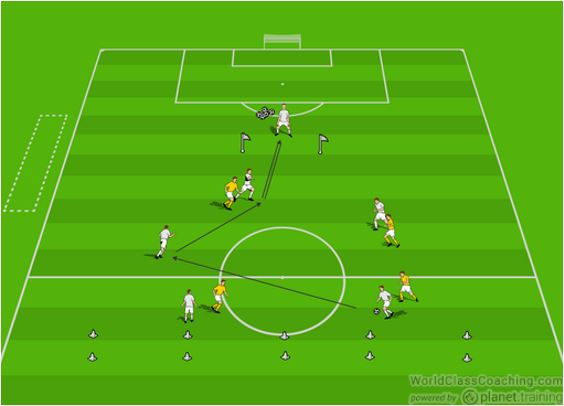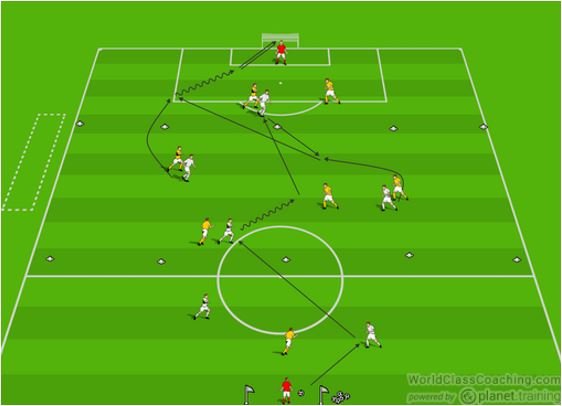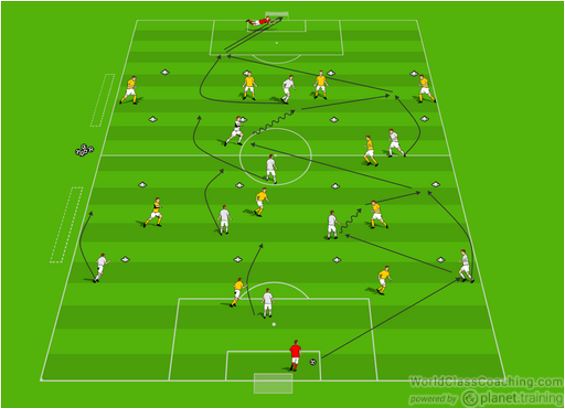By Chris Kouns
USSF A License (USSF Coaching Education Instructor) – NSCAA Premier Diploma (NSCAA Coaching Education Associate Staff Coach) – Head Women’s Soccer Coach – Georgia Gwinnett College
Enable players within the 1-4-2-3-1 formation to link the different lines within the formation and build into the attack.
Part 1

Set-Up
In an area roughly 50 yards wide by 35 yards deep you will two teams with one target player. The target player can be a GK or you can incorporate the #9 player who would be your usual target at the top of this formation. The two teams should be made up of your four backs (#2, #3, #4 and #5), your midfielders (Double Pivot #6 / #8 with the three attacking midfielders #10, #7 and #11). One team will be playing to a two yard end zone and one team will be playing to the target in a gate.
Execution
The team of five midfielders will try to play the ball to the target in the gate. The team of four defenders will try to deny the penetration and then work the ball into the end zone once they gain possession.
Coaching Points
The unit of five players should move the ball quickly to find the numerical advantage and then exploit it by going forward in that area.
The #7 and #11 players must maintain their width and not attempt to break the line with their runs until the space has been made available for them. The patience to stay long enough to allow the #9 or the other attacking mid to move the central defenders and open those gaps that can be exploited is vital.
When the opportunity presents itself to eliminate the lines of defenders it must be seized immediately.
Part 2

Setup
On 3/4 of a field (roughly 75 yards long and 75 wide - if available) you will play to one big goal with a goal keeper and to a target player in a gate goal. The length of the field will be divided into three (3) 25 yard long sections with players stationed in each area based on their roles within the system.
The team attacking the big goal will have a defender in the target goal who will initiate play. If you have a specific defender that you like in the attack I would suggest using this player to breed familiarity with their targets. In the zone closest to the defender will be the double pivot (#6 / #8). In the central zone will be your attacking trio (#7, #10 and #11). In the final third there will be your #9. The team defending the big goal will have two defenders in the grid with the #9. I suggest these two defenders be a #4 and #5. They will have four players in the middle zone and that can be any combination of midfield players. Finally in the top zone there will be one player against the double pivot. This would most likely be a #10 or #9.
Execution
The team attacking the big goal has a couple options in order to score. They can: 1) Play the #9 who will lay the ball back to the attacking trio and then they are free to score. 2) Play the #9 and then have the #7 or #11 joining him in the final grid for a third man running combination. 3) The Double Pivot can carry the ball forward and combine with the attacking trio to eliminate the midfielders. The players defending the big goal must stay in their zones defensively, but, they can move freely when in possession of the ball in order to hit their target.
Variations
You can increase the five to a bank of seven which will give them more vertical pressure. That would mean adding a #9 and #4 to the double pivot and attacking trio.
Coaching Points
The midfield trio must look to find the #9 as soon as that player is available. This will trigger a defensive shift which will allow those players more room to get forward and force the opposing midfielders to face their own goal.
The movement in support of the attacking trio and the two defending players must be constant in order to provide supporting options and overcome eliminate the opposing team.
When the ball moves forward it is vital that the players do as well to continue providing the supporting passing angles. In addition their runs forward in support should be in areas that will exploit the space vacated by the defending unit.
Part 3

Setup
Full size field with both teams playing 11 v 11 to two big goals. The field itself will still remain divided into zones, this time four zones of roughly 25 to 30 yards each depending on your field length.
Execution
In order for a team to score the following conditions should be met: 1) The ball must transition through each zone and not skip any zones. 2) Players should advance with the ball compacting the team into no more than three zones once the ball has reached the second zone. That means with the defenders coming into that zone to support play it is vital the GK supports play off their line.
Coaching Points
When the ball is played into the #9 at least one member of the attacking trio must maintain the width while another must be available centrally for any potential combination opportunities.
When the attacking trio does move into the final third to support the ball the double pivot must be close enough to maintain possession if the attack stalls but still deep enough to prevent any counter attacking opportunities should it be lost.
By Chris Kouns: USSF A License (USSF Coaching Education Instructor) – NSCAA Premier Diploma (NSCAA Coaching Education Associate Staff Coach) – Head Coach Georgia Gwinnet College Women’s Soccer (GA)


